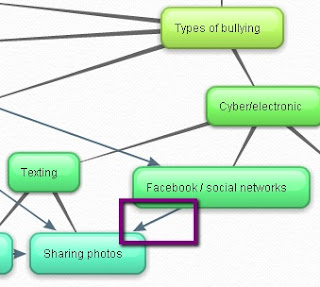Mapping Your Mind With Bubbl.us
I am not a visual
learner. That’s what I told myself, anyway, when studying for college exams with
a friend and attempting to make sense of the crazy bubbles that comprised his
history notes. He tried to convince me that the mess of scribbles he called a
“mind map” was an excellent way of note-taking, but I stubbornly stuck to my
chronological, college-ruled list.
A mind map begins with a
key concept or idea written in the center of a piece of paper or electronic
space, and the idea is usually enclosed in a bubble. Related ideas, also in
bubbles, branch out from that center idea. As the writer
adds more and more ideas, making additional branches and sub-branches, the
writer can also use lines or arrows to connect ideas. I realized the beauty of
those interconnected bubbles years later when, older and wiser, I tried mind
mapping for a graduate school assignment. If I had used a mind map back in
college and been able to better visualize the relationships between the events,
people, and social movements that I was studying, I might have scored better on
that history exam.
To create a mind map, you
can use good old pen and paper or a free electronic mapping tool like Bubbl.us, which allows you to color code
your ideas and easily add, delete, and rearrange bubbles. I’ll use screenshots
from Bubbl.us here to show how a mind map
begins and develops.
So, let’s say you’re
writing a paper on bullying in U.S. high schools. This main topic goes in a bubble
in the center of the page:
Next, start branching off
of that central bubble with related ideas. What comes to mind when you think
about bullying in U.S. high schools? What do you know from course work, preliminary
research, or personal experience? For example, the topic might make you think
about prevention programs, effects of bullying, and different types of
bullying. These subtopics can each go in a bubble that branches off from the
main bubble, like this:
Then, keep branching off
of these bubbles with additional ideas, categories, subcategories—anything you
can think of that’s related, including words, phrases, facts, quotations,
questions, examples, and sources. Pretty soon, your mind map will start looking
like this:
As your mind map grows,
use arrows to connect your ideas. You might first think about sharing photos as
a type of bullying done through text messaging, for example, but then realize
that bullying through Facebook can also involve sharing photos. Even though the
“Sharing photos” bubble branches off of the “Texting” bubble, you can link
“Facebook/social networks” to “Sharing photos” with an arrow.
Creating a mind map can
be a freeing way to capture and connect all of your ideas on a topic. Even if
you’re more comfortable with a traditional outline, you might find—as I
did—that using a different form of brainstorming and note-taking can help expand
your thinking and see connections you might have otherwise missed. Also, looking
at the overall structure of your mind map can help you determine if you need to
broaden or narrow your topic to match the scope of your assignment.
Next time you need to
choose a paper topic, take notes, or beat a writer’s block, try this exercise:
- Get out a piece of paper or sign up for Bubbl.us (you can save up to three mind maps with a free account).
- Put your main idea in a bubble at the center of the page or space.
- Spend 10 minutes building your mind map, creating additional bubbles and sub-bubbles that branch off of your main idea.
- Pause, and look at your whole map. Draw lines or arrows to connect related ideas.
Here are a couple tips to keep in mind:
- Use words and phrases, rather than full sentences, in your bubbles.
- Don’t worry about your map looking professional—it’s okay to go a little wild, and it’s okay if no one else understands how to read your map. Your map only needs to make sense to you.
- Don’t limit yourself! The more bubbles, the better. Getting your ideas down on paper (or a screen) can spark others. Afterward, you can always delete bubbles that do not belong.
Mind mapping is not just
for academic writing. It can be a helpful tool in the workplace, too. The Wall Street Journal recently published
an
article on how one financial advisory firm is using mind mapping to help
clients negotiate financial planning.
----------------------------------------------------------------------------------------------------
A former teacher of college
composition courses, Writing Instructor Anne Shiell is a self-described punctuation geek.
Subscribe to:
Post Comments
(
Atom
)








I like this idea! i really liked the way that you illustrated it - and your comment about not keeping it neat but going a little wild. Thanks for sharing, Anne.
ReplyDeleteJudy
You're welcome, Judy! Thanks for commenting!
ReplyDelete- Anne
Hi Shalin Siriwaradhana! Thanks for the tip regarding mind map software.
ReplyDelete